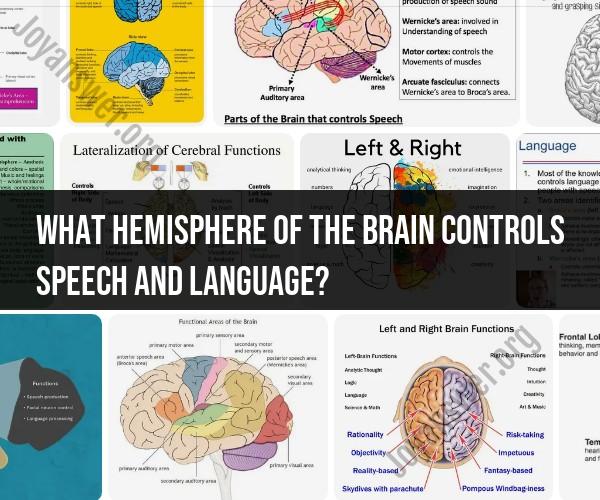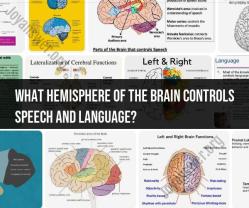What hemisphere of the brain controls speech and language?
In the vast majority of right-handed individuals and a significant portion of left-handed individuals, speech and language control are primarily localized in the left hemisphere of the brain. This region is known as the left hemisphere's perisylvian area and includes several important structures, such as:
Broca's Area: Located in the left frontal lobe, Broca's area is involved in the production of speech and the coordination of the muscles necessary for speech production.
Wernicke's Area: Situated in the left temporal lobe, Wernicke's area plays a crucial role in language comprehension and the understanding of spoken and written language.
Arcuate Fasciculus: This bundle of nerve fibers connects Broca's area and Wernicke's area, facilitating communication between the regions responsible for language production and comprehension.
It's important to note that while left hemisphere dominance for speech and language is the norm, there are exceptions. In a small percentage of left-handed individuals, speech and language functions may be distributed differently, with some degree of right hemisphere involvement. Additionally, some individuals may have atypical brain organization due to conditions such as brain injury or developmental differences.
Overall, while left hemisphere dominance for language is a general pattern in the population, the brain's organization can exhibit variations among individuals. Brain imaging techniques, such as functional MRI (fMRI), can provide insights into the specific brain regions responsible for language in a given person.
Speech and Language Control: Exploring the Brain's Hemispheric Dominance
The brain's two hemispheres, the left and right, are each specialized for different functions. The left hemisphere is generally dominant for language and speech, while the right hemisphere is more dominant for visual-spatial processing and creativity.
However, it is important to note that both hemispheres of the brain play a role in speech and language. For example, the right hemisphere is involved in understanding the emotional tone of speech and in producing prosody (the rhythm and melody of speech).
Left Brain vs. Right Brain: Understanding Language and Speech Centers
The left hemisphere of the brain is home to Broca's area and Wernicke's area, two of the most important brain regions for speech and language.
- Broca's area is responsible for the production of speech. It is located in the frontal lobe of the brain, just above the right eye. Damage to Broca's area can result in a condition called Broca's aphasia, which is characterized by difficulty speaking and forming words.
- Wernicke's area is responsible for the comprehension of language. It is located in the temporal lobe of the brain, just behind the left ear. Damage to Wernicke's area can result in a condition called Wernicke's aphasia, which is characterized by difficulty understanding speech and producing meaningful language.
The Brain's Speech Hub: Hemisphere Insights on Language Control
Recent research has shown that the brain's speech control system is more complex than previously thought. In addition to Broca's area and Wernicke's area, a number of other brain regions are involved in speech and language.
For example, the insula, a brain region located deep within the brain, is involved in coordinating the movements of the tongue, lips, and jaw during speech production. The cerebellum, a brain region located at the back of the brain, is involved in controlling the timing and coordination of speech movements.
The brain's speech control system is also highly interconnected, with different brain regions communicating with each other to produce and understand speech. This interconnectedness allows the brain to flexibly adapt to different speech contexts, such as speaking to a large group of people or having a conversation in a noisy environment.
Overall, the brain's speech control system is a complex and multifaceted system that involves both hemispheres of the brain. While the left hemisphere is generally dominant for language and speech, the right hemisphere also plays an important role in these functions.




